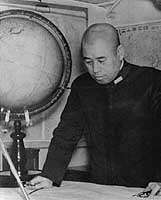- Author
- NHSA Webmaster
- Subjects
- Biographies and personal histories, WWII operations, History - WW2
- Tags
-
- RAN Ships
- None noted.
- Publication
- June 2007 edition of the Naval Historical Review (all rights reserved)
Editor’s Note: This essay was submitted as a graduation essay in History at the RANC, and is reproduced here with the kind permission of Lieutenant Desmond Woods, RAN, History Co-ordinator, at the College. For the sake of conformity with the overall format of this magazine, I have removed footnotes and references.
Introduction
The attack on Pearl Harbour, 7 December 1941, was conceived by Isoroku Yamamoto and developed into one of the most studied and controversial military achievements. On a political level, the attack was a disaster for Japan, rousing American passions for revenge due to it being a sneak attack.

To understand Yamamoto’s leadership style and the limiting factors that pushed him into a war that he opposed, a Japanese perspective needs to be considered in relation to his upbringing in Japan, the education that he received in America and the knowledge that he received from military positions held in both America and London.
Background
Isoroku Yamamoto was born Isoroku Takano, in 1884. His 56 year-old father was a schoolmaster of samurai descent. At the age of 30, Isoroku was adopted into the sonless Yamamoto family, where he assumed the family name.
He graduated 7th from the Imperial Japanese Naval Academy in 1904, went on to study English at Harvard University from 1919–21 and became a Junior Naval Attaché to several nations. He also learned about the United States, and became familiar with its strengths and weaknesses much better than other Japanese officers who never visited in America. It was during his time in America that he developed a keen interest in military aviation in a maritime environment.
During 1926–28, Yamamoto was the Senior Naval Attaché to Washington DC and a delegate to the London Naval Disarmament Conference in 1930. His opinion of the US Navy was low, and he described it as ‘…a club of golfers and bridge players.’ Despite his thoughts on the US Navy, he was fully aware of the United States’ industrial strength and political power. Yamamoto had been adamant that Japan should on no account risk war with the West, specifically America. He had seen for himself how far American resources outstripped those of Japan, and understood clearly that if a war should ever come – and if it should be prolonged – Japan would have no prospect of ultimate victory. In September 1941, the then Japanese Prime Minister asked Yamamoto what Japan’s chances were in a long war and he famously replied, ‘If I am told to fight regardless of the consequences, I shall run wild considerably for the first six months or a year; but I have utterly no confidence in the second and third years’.
Yamamoto’s Battle Within
Japan’s army had many centuries-old samurai traditions for its foundations while the navy had accepted a more Western sense of honour which caused much conflict between the two. This was predominately brought about because Japan’s army leaders did not receive long tours of training overseas with the Royal Navy as the Japanese navy did. The Japanese navy adopted many western customs. One in particular, at least until Yamamoto’s death, was to rescue enemy personnel from the sea after their ship had been defeated. The sailors from the warring nations fought against ships, not the men in them. After Yamamoto’s death, when total defeat was looming, many atrocities against western sailors were carried out.
In the late 1930s, Japan had become one of the most modern and powerful navies in the world and Yamamoto had been a driving force and a great contributor to its increase in military strength and prowess.
Despite his influence, his opposition to the extremely militarist Japanese government and army to entering into a war resulted in a plot to murder him in 1939. As a consequence, he was sent back to sea to protect him from the extremists.
A True Leader
Despite Yamamoto’s serious concerns, when the decision was finally made to enter into war with America, he was obliged to plan for hostilities. Yamamoto’s actions can be summarized in two sentences. Firstly, using every possible resource, he displayed a determined opposition to Japan’s entry into the war. Secondly, when war became inevitable, he displayed an equally determined application of every possible resource to the war’s successful prosecution. Yamamoto was prepared to argue for what he believed was best for his nation and its people but ultimately, his Japanese heritage and military training would force him to accept his duties and lead his troops with nothing less than 100% commitment into a war with America and its allies. There were times in his career when he was filled with doubt about the direction that Japan had chosen. Regardless of his feelings, he always appeared optimistic in front of his men to show he was still their leader and ready to fight without fear of death. He ruled the Combined Fleet with intimidation and would utilize his popularity within the fleet to manipulate decisions regarding objectives that he considered important.




